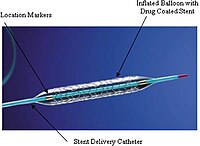
Photo from wikipedia
PURPOSE We compared the efficacy and safety of complete and conventional stent placement to relieve ureteral stent related symptoms. MATERIALS AND METHODS We randomized 85 patients who required ureteral stent… Click to show full abstract
PURPOSE We compared the efficacy and safety of complete and conventional stent placement to relieve ureteral stent related symptoms. MATERIALS AND METHODS We randomized 85 patients who required ureteral stent placement after lithotripsy into an intraureteral or a conventional stent placement group. The ureteral stent remained in place until postoperative day 14. We evaluated scores on the visual analog scale pain, the SF-36 (36-Item Short-Form Health Survey), the I-PSS (International Prostate Symptom Score) and the OABSS (Overactive Bladder Symptom Score) on postoperative days 3 and 14. We also assessed the total amount of analgesics administered and stent related complications. RESULTS Overall the records of 80 patients were analyzed. Pain scores were significantly lower in the intraureteral vs the conventional stent placement group (postoperative days 3 and 14, 4.85 vs 9.78, p = 0.003, and 3.15 vs 6.20, p = 0.014, respectively). The total I-PSS score (postoperative days 3 and 14, 10.41 vs 14.90, p = 0.006, and 11.67 vs 16.10, p = 0.022, respectively) and total analgesic use (19.23 vs 88.54 mg, p <0.001) were significantly lower in the intraureteral group. However, differences in the SF-36 and the total OABSS scores did not significantly differ. On subgroup analysis the pain score in the groin and bladder areas, incomplete emptying and daytime frequency on the I-PSS, the quality of life index and daytime frequency on the OABSS were significantly better in the intraureteral stent placement group than the conventional stent placement group on postoperative days 3 and 14 (all p <0.05). There was no difference in the complication rate between the 2 groups. CONCLUSIONS Intraureteral stent placement may be associated with less ureteral stent related discomfort than conventional stent placement. This novel placement method is feasible and safe, and it can be immediately used in daily clinical practice.
Journal Title: Journal of Urology
Year Published: 2019
Link to full text (if available)
Share on Social Media: Sign Up to like & get
recommendations!